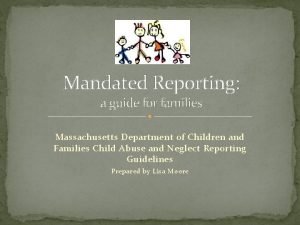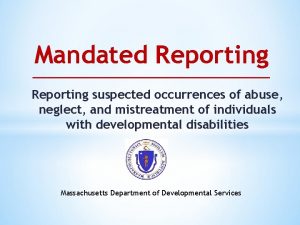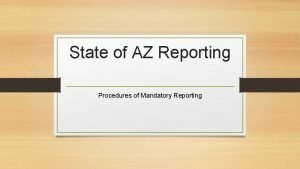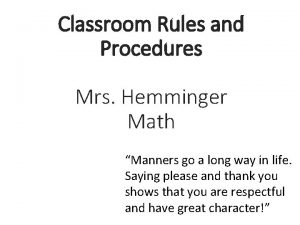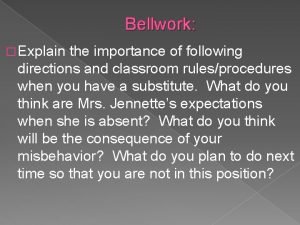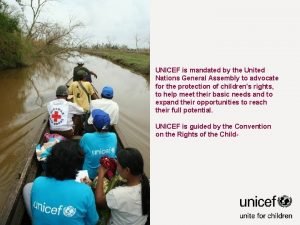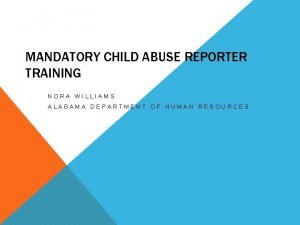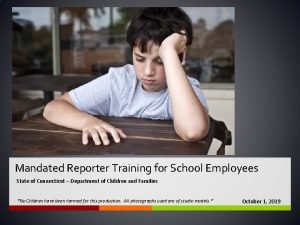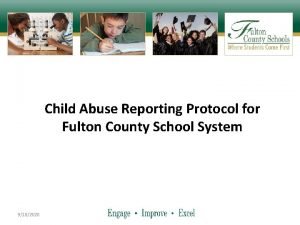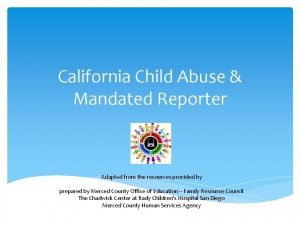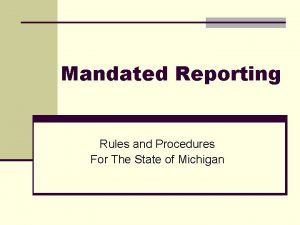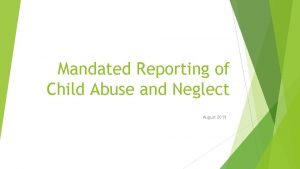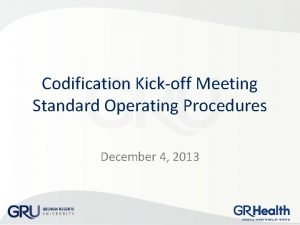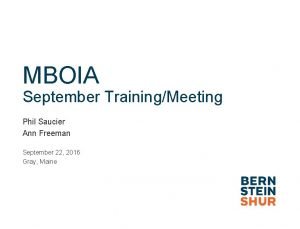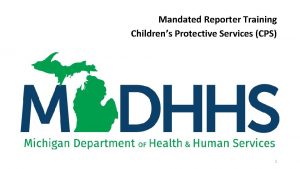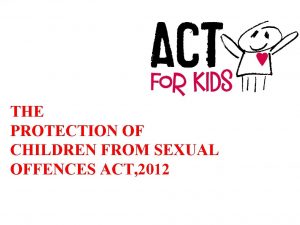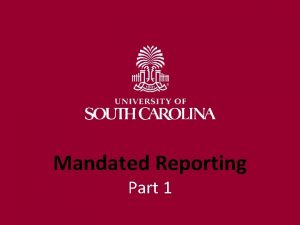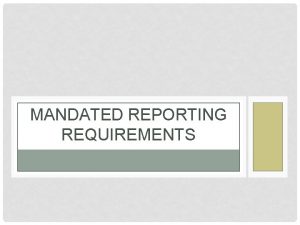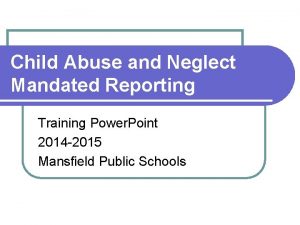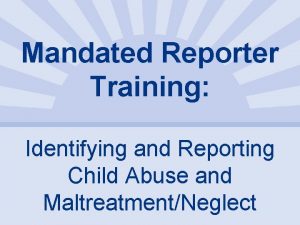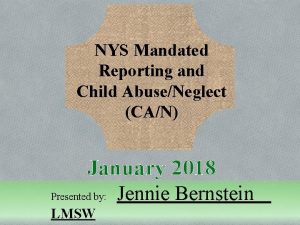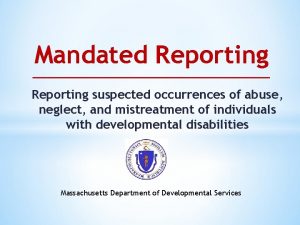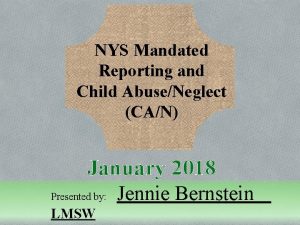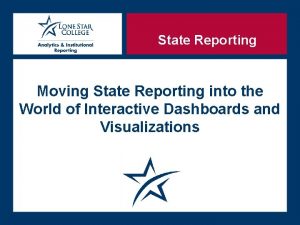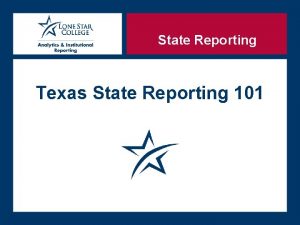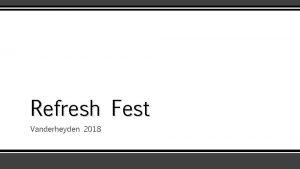Mandated Reporting Rules and Procedures For The State

















- Slides: 17

Mandated Reporting Rules and Procedures For The State of Michigan

What Is a Mandated Reporter? n The Michigan Child Protection Law requires certain professionals to report their suspicions of child abuse or neglect to Children's Protective Services (CPS) at the Department of Human Services (DHS). These people are mandated reporters and have established relationships with children based on their profession. Mandated reporters include:

Who is a mandated reporter? n n n n n n Physicians. Dentists. Physician's assistants. Registered dental hygienists. Medical examiners. Nurses. Licensed emergency medical care providers. Audiologists. Psychologists. Marriage and family therapists. Licensed professional counselors. Social workers. Licensed master's social workers. Licensed bachelor's social workers. Registered social service technicians. Social service technicians. Persons employed in a professional capacity in any office of the Friend of the Court. School administrators. School counselors. Teachers. Law enforcement officers. Members of the clergy. Regulated child care providers. Employees of an organization or entity that, as a result of federal funding statutes, regulations, or contracts, would be prohibited from reporting in the absence of a state mandate or court order (e. g. , domestic violence provider). n YOU!

Potential Indicators of Child Abuse and/or Neglect n Determining when to report suspected child abuse or neglect can be difficult. A bruise on a toddler's forehead may be the result of learning to walk or the result of abuse. When in doubt, contact the local DHS office for consultation.

Physical Neglect - Physical Indicators n Unattended medical needs. n Lack of supervision. n Regular signs of hunger, inappropriate dress, poor hygiene. n Distended stomach, emaciated. n Significant weight change.

Physical Neglect - Behavioral Indicators n Regularly displays fatigue or listlessness, falls asleep in class. n Steals/hoards food, begs from classmates. n Reports that no caretaker is at home.

Physical Abuse - Physical Indicators n Unexplained bruises (in various stages of healing), n n n n n welts, loop marks. Adult/human bite marks. Bald spots or missing clumps of hair. Unexplained burns/scalds. Unexplained fractures, skin lacerations/punctures or abrasions. Swollen lips/chipped teeth. Linear/parallel marks on cheeks and temple area. Crescent-shaped bruising. Puncture wounds. Bruising behind the ears.

Physical Abuse - Behavioral Indicators n Self-destructive/self-mutilation. n Withdrawn and/or aggressive-behavior extremes. n Uncomfortable/skittish with physical contact. n Arrives at school late or stays late as if afraid to be at n n home. Chronic runaway (adolescents). Complains of soreness or moves uncomfortably. Wears clothing inappropriate to weather, to cover body. Lack of impulse control (e. g. inappropriate outbursts).

Sexual Abuse - Physical indicators n Pain or itching in genital area. n Bruises or bleeding in genital area. n Sexually transmitted disease. n Frequent urinary or yeast infections. n Extreme or sudden weight change. n Pregnancy under 12 years of age.

Sexual Abuse - Behavioral Indicators n Withdrawal, chronic depression. n Sexual behaviors or references that are unusual for the child's age. n Seductive or promiscuous behavior. n Poor self-esteem, self-devaluation, lack of confidence. n Suicide attempts (especially adolescents). n Hysteria, lack of emotional control.

How To Make A Report of Suspected Child Abuse/Neglect n #1: Mandated reporters are required to make an immediate verbal report to CPS n The verbal report can be completed by calling toll free (800) 942 -4357 or calling the local county DHS children’s protective services unit.

How To Make A Report of Suspected Child Abuse/Neglect The individual who had contact with the child must complete the call and provide as much detail as possible about the following information: n n n The child's primary caretaker, including name and address. Names and birth dates for all members of the household. Name and birth date of the alleged perpetrator(s). Whether the alleged perpetrator lives with the child. Address where the alleged abuse or neglect occurred. What makes the mandated reporter suspect the child is being abused or neglected.

How To Make A Report of Suspected Child Abuse/Neglect n #2: Mandated reporters are required to make a written report within 72 hours. if the mandated reporter suspects child abuse or neglect. Mandated reporters must also notify the head of their organization of the report. Reporting the suspected allegations of child abuse and/or neglect to the head of the organization does not fulfill the requirement to report directly to DHS.

How To Make A Report of Suspected Child Abuse/Neglect The Child Protection Law requires that the written report include the following information: n n n Name of child. Description of abuse or neglect. Names and addresses of child's parents/guardians. The persons with whom the child resides. Child's age. Other information available to the reporting person that might establish the cause of the abuse or neglect, and the manner in which the abuse or neglect occurred.

Confidentiality of a Mandated Reporter's Identity n The identity of a reporting person is confidential under the Child Protection Law. The identity of a reporting person is subject to disclosure only with the consent of that person, by judicial process or to those listed under Section 5 of the Child Protection Law (MCL 722. 625).

Civil and Criminal Liability n Mandated reporters, who fail to file a report of suspected child abuse or neglect, will be subject to both civil and criminal liability. In a civil action, the mandated reporter may be held liable for all damages that any person suffers due to the mandated reporter's failure to file a report. In a criminal action, the mandated reporter may be found guilty of a misdemeanor punishable by imprisonment for up to 93 days and a fine of $500. n A person making a good faith report is protected from civil and criminal prosecution and cannot be penalized for making the report or cooperating with a CPS investigation.

Mandated Reporter Hotline n If a mandated reporter is dissatisfied with the response by DHS, the mandated reporter may contact the Mandated Reporter Hotline at (877) 277 -2585. Prior to calling the hotline, the mandated reporter must first attempt to talk with the local DHS office director about their concerns.
 Mandatory reporting guidelines in massachusetts
Mandatory reporting guidelines in massachusetts Dppc mandated reporting
Dppc mandated reporting Mandatory reporting arizona
Mandatory reporting arizona Math class rules and procedures
Math class rules and procedures Classroom rules and procedures
Classroom rules and procedures Unicef is mandated
Unicef is mandated Mandatory reporting alabama
Mandatory reporting alabama Mandated reporter training ct
Mandated reporter training ct Georgia dfcs investigation protocol
Georgia dfcs investigation protocol Canra passed
Canra passed Tasl
Tasl Michigan mandated reporter guide
Michigan mandated reporter guide Mandated reporter louisiana
Mandated reporter louisiana Pa mandated reporter laws
Pa mandated reporter laws Kick off stage is mandated for
Kick off stage is mandated for Is dr phil a mandated reporter
Is dr phil a mandated reporter Michigan cps 3200
Michigan cps 3200 Mandated reporter definition
Mandated reporter definition
